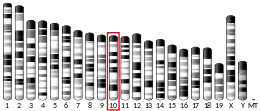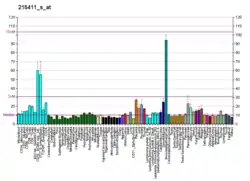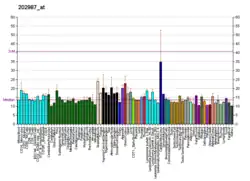| TRAF3IP2 | |||||||||||||||||||||||||||||||||||||||||||||||||||
|---|---|---|---|---|---|---|---|---|---|---|---|---|---|---|---|---|---|---|---|---|---|---|---|---|---|---|---|---|---|---|---|---|---|---|---|---|---|---|---|---|---|---|---|---|---|---|---|---|---|---|---|
| Identifiers | |||||||||||||||||||||||||||||||||||||||||||||||||||
| Aliases | TRAF3IP2, ACT1, C6orf2, C6orf4, C6orf5, C6orf6, CANDF8, CIKS, PSORS13, TRAF3 interacting protein 2 | ||||||||||||||||||||||||||||||||||||||||||||||||||
| External IDs | OMIM: 607043 MGI: 2143599 HomoloGene: 15885 GeneCards: TRAF3IP2 | ||||||||||||||||||||||||||||||||||||||||||||||||||
| |||||||||||||||||||||||||||||||||||||||||||||||||||
| |||||||||||||||||||||||||||||||||||||||||||||||||||
| |||||||||||||||||||||||||||||||||||||||||||||||||||
| |||||||||||||||||||||||||||||||||||||||||||||||||||
| |||||||||||||||||||||||||||||||||||||||||||||||||||
| Wikidata | |||||||||||||||||||||||||||||||||||||||||||||||||||
| |||||||||||||||||||||||||||||||||||||||||||||||||||
Adapter protein CIKS is a protein that in humans is encoded by the TRAF3IP2 gene.[5][6][7]
This gene encodes a protein involved in regulating responses to cytokines by members of the Rel/NF-kappaB transcription factor family. These factors play a central role in innate immunity in response to pathogens, inflammatory signals and stress. This gene product interacts with TRAF proteins (tumor necrosis factor receptor-associated factors) and either I-kappaB kinase or MAP kinase to activate either NF-kappaB or Jun kinase. Two alternative transcripts encoding different proteins have been identified. A third transcript, which does not encode a protein and is transcribed in the opposite orientation, has been identified. Overexpression of this transcript has been shown to reduce expression of at least one of the protein encoding transcripts, suggesting it has a regulatory role in the expression of this gene.[7]
Cellular function
TRAF3IP2 is the key activator of Th17-mediated inflammatory responses but also suppresses the humoral B cell response by negatively regulating CD40L and BAFF signaling.[8] TRAF3IP2 seems to be more specific to Brucella infections than other Gram-negative bacteria. In the study of Degos et al., TRAF3IP2 expression was increased fourfold in human blood DCs after exposure to the Brucella virulence factor CβG (β-1,2 cyclic glucan) compared to the E. coli lipopolysaccharides (LPS)[9] CβG is a highly abundant virulence factor of Brucella that modulates membrane rafts of the infected cell necessary for the intracellular escape (Arellano-Reynoso et al., 2005). It is thus one of the most Brucella-specific toxins recognized by immune cells.[9][10] LPS is another important Gram-negative virulence factor. However, it is altered in Brucella, so it is only weakly immunostimulatory.[11][12] Also, TRAF3IP2 and Th2-LCR lncRNA expression was particularly increased in the acute phase of brucellosis. During relapse phase of brucellosis, TRAF3IP2 expression seemed to decrease, whereas the Th2-LCR lncRNA level remained high.[13]
Interactions
References
- 1 2 3 GRCh38: Ensembl release 89: ENSG00000056972 - Ensembl, May 2017
- 1 2 3 GRCm38: Ensembl release 89: ENSMUSG00000019842 - Ensembl, May 2017
- ↑ "Human PubMed Reference:". National Center for Biotechnology Information, U.S. National Library of Medicine.
- ↑ "Mouse PubMed Reference:". National Center for Biotechnology Information, U.S. National Library of Medicine.
- 1 2 Leonardi A, Chariot A, Claudio E, Cunningham K, Siebenlist U (September 2000). "CIKS, a connection to Ikappa B kinase and stress-activated protein kinase". Proceedings of the National Academy of Sciences of the United States of America. 97 (19): 10494–10499. Bibcode:2000PNAS...9710494L. doi:10.1073/pnas.190245697. PMC 27052. PMID 10962033.
- 1 2 Li X, Commane M, Nie H, Hua X, Chatterjee-Kishore M, Wald D, et al. (September 2000). "Act1, an NF-kappa B-activating protein". Proceedings of the National Academy of Sciences of the United States of America. 97 (19): 10489–10493. Bibcode:2000PNAS...9710489L. doi:10.1073/pnas.160265197. PMC 27051. PMID 10962024.
- 1 2 "Entrez Gene: TRAF3IP2 TRAF3 interacting protein 2".
- ↑ Qian Y, Qin J, Cui G, Naramura M, Snow EC, Ware CF, et al. (October 2004). "Act1, a negative regulator in CD40- and BAFF-mediated B cell survival". Immunity. 21 (4): 575–587. doi:10.1016/j.immuni.2004.09.001. PMID 15485634.
- 1 2 Degos C, Gagnaire A, Banchereau R, Moriyón I, Gorvel JP (2015). "Brucella CβG induces a dual pro- and anti-inflammatory response leading to a transient neutrophil recruitment". Virulence. 6 (1): 19–28. doi:10.4161/21505594.2014.979692. PMC 4603436. PMID 25654761.
- ↑ Arellano-Reynoso B, Lapaque N, Salcedo S, Briones G, Ciocchini AE, Ugalde R, et al. (June 2005). "Cyclic beta-1,2-glucan is a Brucella virulence factor required for intracellular survival". Nature Immunology. 6 (6): 618–625. doi:10.1038/ni1202. PMID 15880113. S2CID 32005324.
- ↑ Lapaque N, Moriyon I, Moreno E, Gorvel JP (February 2005). "Brucella lipopolysaccharide acts as a virulence factor". Current Opinion in Microbiology. 8 (1): 60–66. doi:10.1016/j.mib.2004.12.003. PMID 15694858.
- ↑ Barquero-Calvo E, Chaves-Olarte E, Weiss DS, Guzmán-Verri C, Chacón-Díaz C, Rucavado A, et al. (July 2007). "Brucella abortus uses a stealthy strategy to avoid activation of the innate immune system during the onset of infection". PLOS ONE. 2 (7): e631. Bibcode:2007PLoSO...2..631B. doi:10.1371/journal.pone.0000631. PMC 1910614. PMID 17637846.
- ↑ Gheitasi R, Keramat F, Khosravi S, Hajilooi M, Pletz MW, Makarewicz O (2021). "Evaluation of Th2 and Th17 Immunity-Related Factors as Indicators of Brucellosis". Frontiers in Cellular and Infection Microbiology. 11: 786994. doi:10.3389/fcimb.2021.786994. PMC 8777051. PMID 35071039.
 This article incorporates text by Reza Gheitasi available under the CC BY 1.0 license.
This article incorporates text by Reza Gheitasi available under the CC BY 1.0 license.
Further reading
- Morelli C, Magnanini C, Mungall AJ, Negrini M, Barbanti-Brodano G (July 2000). "Cloning and characterization of two overlapping genes in a subregion at 6q21 involved in replicative senescence and schizophrenia". Gene. 252 (1–2): 217–225. doi:10.1016/S0378-1119(00)00231-6. PMID 10903453.
- Qian Y, Zhao Z, Jiang Z, Li X (July 2002). "Role of NF kappa B activator Act1 in CD40-mediated signaling in epithelial cells". Proceedings of the National Academy of Sciences of the United States of America. 99 (14): 9386–9391. Bibcode:2002PNAS...99.9386Q. doi:10.1073/pnas.142294499. PMC 123150. PMID 12089335.
- Chariot A, Leonardi A, Muller J, Bonif M, Brown K, Siebenlist U (October 2002). "Association of the adaptor TANK with the I kappa B kinase (IKK) regulator NEMO connects IKK complexes with IKK epsilon and TBK1 kinases". The Journal of Biological Chemistry. 277 (40): 37029–37036. doi:10.1074/jbc.M205069200. PMID 12133833.
- Xia YF, Li YD, Li X, Geng JG (August 2002). "Identification of alternatively spliced Act1 and implications for its roles in oncogenesis". Biochemical and Biophysical Research Communications. 296 (2): 406–412. doi:10.1016/S0006-291X(02)00887-2. PMID 12163033.
- Kanamori M, Kai C, Hayashizaki Y, Suzuki H (December 2002). "NF-kappaB activator Act1 associates with IL-1/Toll pathway adaptor molecule TRAF6". FEBS Letters. 532 (1–2): 241–246. doi:10.1016/S0014-5793(02)03688-8. PMID 12459498. S2CID 83623149.
- Matsuda A, Suzuki Y, Honda G, Muramatsu S, Matsuzaki O, Nagano Y, et al. (May 2003). "Large-scale identification and characterization of human genes that activate NF-kappaB and MAPK signaling pathways". Oncogene. 22 (21): 3307–3318. doi:10.1038/sj.onc.1206406. PMID 12761501. S2CID 38880905.
- Mauro C, Vito P, Mellone S, Pacifico F, Chariot A, Formisano S, Leonardi A (September 2003). "Role of the adaptor protein CIKS in the activation of the IKK complex". Biochemical and Biophysical Research Communications. 309 (1): 84–90. doi:10.1016/S0006-291X(03)01532-8. hdl:2268/1240. PMID 12943667.
- Rual JF, Venkatesan K, Hao T, Hirozane-Kishikawa T, Dricot A, Li N, et al. (October 2005). "Towards a proteome-scale map of the human protein-protein interaction network". Nature. 437 (7062): 1173–1178. Bibcode:2005Natur.437.1173R. doi:10.1038/nature04209. PMID 16189514. S2CID 4427026.





